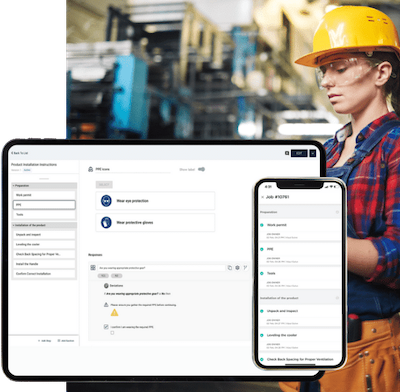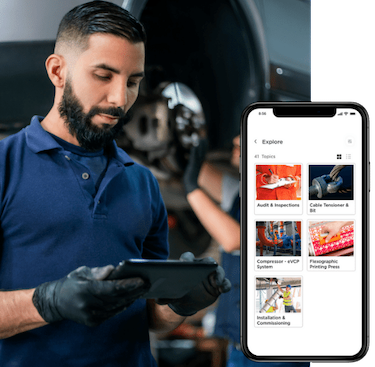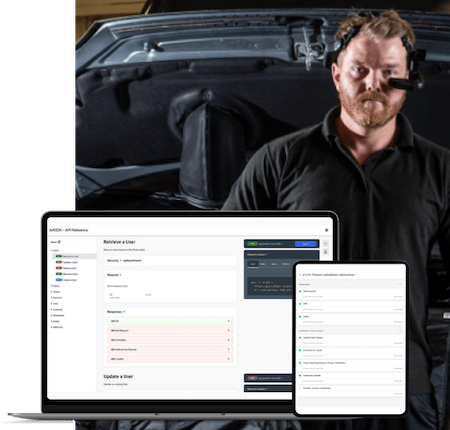
Praxworxs: Atheer FSM frequently asked questions.
Discover answers to common questions with our comprehensive FAQ.
Find the information you need quickly and easily. Simplify your experience with our clear and concise FAQ section.
Embark on a journey of seamless operations, augmented reality support, and empowered teams through our comprehensive FAQ page. Whether you're delving into the intricacies of Field Service Management, exploring the possibilities of AR Remote Assistance, optimizing your Connected Worker initiatives, or enhancing Employee Onboarding and Training with a focus on skills compliance – we've got you covered.
Unlock insights into the convergence of technology and workforce dynamics with our expertly curated FAQs. Troubleshoot, discover best practices and gain in-depth knowledge across various topics designed to elevate your operations.
Frequently Asked Questions
-
Field Service Management (FSM) refers to coordinating and managing a company's field service operations. It involves managing a team of field service technicians responsible for going into the field to perform various tasks, such as repairs, installations, inspections, and maintenance.
Field Service Management typically involves a combination of software solutions, mobile devices, and communication tools to streamline and optimise field operations. These tools enable field technicians to receive work orders, access customer information, track their time and activities, generate invoices, and communicate with the office and customers in real time.
The primary goal of FSM is to improve the efficiency and effectiveness of field service operations, resulting in increased productivity, customer satisfaction, and profitability for the company. By effectively managing and tracking field work, companies can minimise downtime, reduce costs, and ensure that customer requests are addressed promptly and accurately.
Here are a few examples of how FSM can benefit different industries:
HVAC Services: A company that provides heating, ventilation, and air conditioning services can use FSM software to assign and schedule technicians to various service requests. With real-time GPS tracking, the software can optimise routes and help technicians reach customers quickly. It also allows technicians to access customer service history, equipment details, and troubleshooting guides, enabling them to diagnose and resolve issues efficiently.
Telecommunications: In the telecommunications industry, FSM can be used to manage the installation and maintenance of network infrastructure and equipment. FSM software can automate the dispatching of technicians based on their skills and availability, ensuring that the right technician with the necessary equipment and expertise is assigned to each job. This helps reduce downtime and improves customer satisfaction by providing timely and accurate service.
Power and Energy: Utility companies, such as electricity and water providers, can benefit from FSM by efficiently managing meter installations, repairs, and maintenance. Field technicians equipped with FSM tools can receive accurate work orders, access customer information, and record meter readings in real-time. This data can then be synchronised with the back-office systems, enabling precise billing and usage tracking.
Field Service Management plays a crucial role in enhancing the efficiency and effectiveness of field service operations across various industries. By leveraging technology and optimising workflows, companies can improve customer satisfaction, reduce costs, and gain a competitive advantage in the market.
-
Field Service Management software is a type of software that is designed to help organisations manage and optimise their field service operations. Field service operations typically involve dispatching technicians or service personnel to customer sites or remote locations to perform various services, such as repairs, installations, maintenance, or inspections.
Field Service Management software provides a range of functionalities to help organisations manage their field service operations more efficiently and effectively. Some of the most common features of Field Service Management software include:
Scheduling and dispatching: This feature allows organisations to assign technicians to specific jobs and schedule their work based on availability, skillset, location, and other factors.
Work order management: This feature enables organisations to manage work orders, track their status, and update them in real-time as technicians complete their tasks.
Asset management: This feature helps organisations track the assets or equipment they use in their field service operations, such as vehicles, tools, spare parts, and other resources.
Mobile access: This feature allows technicians to access and update work orders, schedules, and other information from their mobile devices, enabling them to work more efficiently and independently in the field.
Reporting and analytics: This feature gives organisations insights into their field service operations, such as service performance, customer satisfaction, technician productivity, and other vital metrics.
Field Service Management software is used in various industries, such as utilities, telecommunications, healthcare, mining, oil and gas, manufacturing, logistics and construction.
-
Augmented Reality (AR) has emerged as a game-changing technology in various industries, and field service operations are no exception. By overlaying digital information in the real world, AR enhances the capabilities of field service technicians and improves overall operational efficiency. Here are some key benefits of adopting augmented reality in field service operations:
Enhanced Remote Support: AR enables remote experts to provide real-time guidance to field technicians. Using AR glasses or mobile devices, technicians can receive step-by-step instructions, view 3D models, and even share their live field of view with experts. This eliminates the need for experts to physically be present at the site, reducing travel costs and ensuring faster problem resolution.
For example, technicians working on complex machinery in the energy sector can use AR to consult experts from headquarters virtually, minimising downtime and increasing equipment uptime.
Improved Training and Onboarding: AR allows for immersive and interactive training experiences. Technicians can simulate real-world scenarios using AR devices, helping them gain practical knowledge and skills in a safe environment. This reduces the time and costs associated with traditional training methods.
For instance, in the automotive industry, technicians can use AR to learn how to service new car models without needing physical vehicles, leading to more efficient onboarding processes.
Accurate Asset Maintenance: AR can assist technicians in performing maintenance tasks more accurately. By overlaying digital information on equipment, technicians can quickly identify components, access relevant documentation, and follow step-by-step instructions. This reduces the likelihood of errors and ensures consistent service quality.
AR can guide technicians in complex assembly processes in the manufacturing sector, ensuring that each step is executed correctly and minimising the risk of product defects.
Real-time Data Access: AR enables technicians to access real-time data and information at their fingertips. By integrating with existing systems and databases, AR devices can display critical data such as equipment history, performance metrics, and maintenance schedules. This allows technicians to make informed decisions quickly, improving their productivity and reducing the time spent searching for information.
For example, in the telecommunications industry, technicians can use AR to access network data and troubleshoot connectivity issues more efficiently, leading to faster problem resolution.
Augmented reality offers numerous benefits for field service operations. From remote support and improved training to accurate asset maintenance and real-time data access, AR empowers technicians to work more efficiently, deliver higher-quality service, and drive overall operational excellence. By embracing AR, businesses can gain a competitive edge in an increasingly connected and technologically advanced world.
-
Systems integration with Atheer AR Field Service Management software offers several benefits that can enhance efficiency and effectiveness. Here are some of the key advantages:
Improved Data Accuracy: Atheer AR Field Service Management software can integrate with other systems such as ERP, CRM, and inventory management systems. Integrating these systems allows data to be shared seamlessly, reducing the chances of data entry errors. Field service technicians can make informed decisions with accurate data, resulting in a better overall customer service experience.
Streamlined Workflows: Systems integration enables Atheer AR Field Service Management software to create automated and streamlined workflows. This reduces the time and effort required to complete routine tasks, such as scheduling appointments, dispatching technicians, and sending notifications. With streamlined workflows, field service teams can focus on more critical tasks, such as resolving complex issues and providing exceptional customer service.
Enhanced Visibility: Integration with other systems gives Atheer AR Field Service Management software greater visibility into critical data such as inventory levels, customer information, and service history. This enables field service teams to respond more quickly to customer needs and resolve issues more efficiently.
Increased Efficiency: Atheer AR Field Service Management software can help field service teams work more efficiently by integrating with other systems. For example, if the software is integrated with an inventory management system, field service technicians can easily access parts availability and order parts as needed. This reduces the time required to complete a repair and ensures that the correct parts are available on-site.
Integrating systems with Atheer AR Field Service Management software can help field service organisations improve service levels, reduce costs, and increase efficiency. Organisations can deliver exceptional customer service and achieve better business outcomes by automating routine tasks, providing greater visibility into critical data, and enabling field service teams to work more efficiently.
-
Field Service Management (FSM) software is designed to streamline and optimise the operations of businesses that provide field services. FSM software offers several ways to improve productivity by automating various tasks and providing real-time data.
Efficient scheduling: FSM software allows businesses to schedule and assign tasks more effectively, considering factors such as technician availability, skills, and location. This eliminates manual scheduling errors and ensures the right technician is dispatched to the right job. By reducing travel time and optimising routes, businesses can complete more daily tasks, increasing productivity.
For example, a plumbing company can use FSM software to assign jobs to their technicians based on their proximity to the customer's location, resulting in shorter travel times and increased efficiency.
Real-time updates and communication: FSM software enables technicians to receive job details and updates in real-time through mobile devices. This eliminates the need for phone calls or manual updates, reducing delays and miscommunication. Technicians can also access customer history, equipment details, and service manuals on their mobile devices, allowing them to resolve issues more efficiently.
For instance, an HVAC company can use FSM software to instantly update technicians about changes in job requirements or new appointments, ensuring prompt response and better customer service.
Inventory management: FSM software provides businesses with inventory management tools that help them track and manage their stock levels more effectively. This ensures technicians have the necessary parts and equipment available when needed, avoiding delays caused by missing or incorrect inventory. Productivity is significantly improved by reducing time spent searching for parts or making additional trips for supplies.
For example, an electrical company can use FSM software to monitor their stock levels, automatically triggering reordering when inventory reaches a certain threshold. This ensures that technicians always have the required materials, leading to faster job completion.
Data-driven insights: FSM software generates valuable analytics and reports that provide insights into field service operations. These insights can help businesses identify bottlenecks, measure technician performance, and make data-driven decisions to optimise processes. By analysing data such as job completion rates, response times, and customer satisfaction, businesses can identify areas for improvement and implement strategies to enhance productivity.
For instance, a pest control company can use FSM software to analyse data on technician performance, identify low-performing areas, and provide additional training or support where needed, resulting in increased productivity.
Field Service Management software improves productivity by optimising scheduling, providing real-time updates and communication, streamlining inventory management, and offering data-driven insights. By leveraging the capabilities of FSM software, businesses can enhance efficiency, reduce costs, and deliver better customer service.
-
Atheer Inc. is a leading provider of Augmented Reality (AR) solutions for the enterprise industry. They specialise in developing AR platforms and software that enable businesses to enhance productivity, efficiency, and collaboration in various sectors, including manufacturing, logistics, field service, and healthcare.
Atheer's flagship product, the Atheer AR Platform, offers a range of features and capabilities to empower frontline workers with hands-free access to critical information and real-time guidance. The platform combines AR glasses or smart devices with advanced software, allowing users to overlay digital content onto their physical environment, creating a blended reality experience.
By leveraging Atheer's AR technology, organisations can streamline complex tasks, reduce errors, and improve overall operational performance. For example, in manufacturing, Atheer's solutions enable workers to visualise assembly instructions in real-time, reducing production time and errors. In logistics, AR can provide real-time information on inventory status, optimising order fulfilment processes.
One of Atheer's notable clients is Porsche, where they implemented an AR solution to aid technicians during vehicle repairs. The Atheer AR Platform provided step-by-step visual instructions and hands-free access to technical guidance, significantly improving efficiency and reducing repair times.
In addition to their AR Platform, Atheer also offers a developer platform for businesses looking to create customised AR applications tailored to their specific needs. This allows companies to integrate Atheer's technology into their existing systems and workflows seamlessly.
Atheer Inc. has established itself as a leader in the AR industry, providing innovative solutions that empower enterprises to leverage the full potential of Augmented Reality in their operations. With a strong track record of successful implementations and a commitment to ongoing research and development, Atheer continues to drive the evolution and adoption of AR technology in the enterprise sector.
Praxworxs is a trusted Atheer Global Partner.
-
Augmented Reality (AR) can provide several benefits to Immersive Learning by enhancing the learning experience and making it more engaging and interactive. AR technology allows users to overlay digital information in the real world. When used in Immersive Learning, it can create an environment where learners can interact with virtual objects and scenarios that are overlaid in the real world.
One significant benefit of AR in Immersive Learning is that it can help learners retain information better. AR technology can create a more immersive and engaging learning experience, making it easier to remember what was learned. This immersion type can help learners retain information better than traditional teaching methods.
Another benefit of AR in Immersive Learning is that it can provide learners with a safer way to practice skills and simulate situations that are usually too dangerous or expensive in real life.
Augmented Reality technology can significantly benefit Immersive Learning by enhancing the learning experience, making it more engaging, and providing learners with a safer and more effective way to practice skills and scenarios.
-
Connected worker technology refers to using digital tools and solutions to enhance the saf’ safety, productivity, and efficiency in various industries. This technology leverages the Internet of Things (IoT), wearable devices, sensors, and communication platforms to connect workers to their workplace and relevant data and systems. The goal is to create a more interconnected and informed workforce, often in manufacturing, construction, energy, and healthcare.
Critical features of connected worker technology may include:
Wearable Devices: Workers may use smart helmets, glasses, or other wearables with sensors to monitor their environment, collect data, and provide real-time information.
IoT Sensors: Sensors embedded in equipment, machinery, and the work environment collect data on various parameters, such as temperature, humidity, and equipment status. This data is then used to make informed decisions and optimize processes.
Communication: Connected worker solutions often include communication tools that facilitate real-time collaboration among team members. This can consist of voice communication, video conferencing, and messaging platforms.
Data Analytics: The collected data is analyzed to identify patterns, trends, and potential safety or efficiency improvements. Analytics tools help organizations make data-driven decisions to enhance overall operations.
Augmented Reality (AR): AR technology can be integrated to provide workers with visual information overlaid on their physical environment. This can be particularly useful for tasks that require detailed instructions or troubleshooting.
Safety Monitoring: Connected worker technology may include features such as biometric monitoring or location tracking to ensure the safety of workers, especially in hazardous environments.
Training and Onboarding: The technology may be used for on-the-job training and onboarding processes, providing interactive and immersive experiences for new employees.
Connected worker technology aims to create a more efficient, collaborative, and safer work environment by leveraging modern digital tools and connectivity capabilities.
-
Connected worker technology integrates digital tools and devices that enable employees to collaborate, communicate, and access information in real time. This technology has become increasingly important in today's fast-paced and digitally-driven workplaces. Here are some ways in which connected worker technology can help organisations:
Enhanced Communication and Collaboration: Connected worker technology allows employees to communicate and collaborate more efficiently, regardless of physical location. For example, with the help of instant messaging platforms or project management tools, team members can easily share information, discuss ideas, and work together on projects in real time. This seamless communication and collaboration improve teamwork, productivity, and decision-making.
Streamlined Workflows and Processes: By integrating connected worker technology into various aspects of operations, organisations can streamline workflows and automate repetitive tasks. For instance, mobile applications and cloud-based platforms can enable employees to access and update information on the go, eliminating the need for manual data entry or paperwork. This not only saves time but also reduces errors and improves efficiency.
Improved Safety and Risk Management: Connected worker technology often includes wearables or IoT devices that can collect and analyse data related to employee safety and environmental conditions. For example, smart helmets with sensors can detect and alert workers about potential hazards in real time. This technology allows organisations to proactively address safety concerns, minimise workplace accidents, and ensure compliance with regulatory standards.
Real-time Data and Analytics: Connected worker technology enables organisations to gather real-time data from various sources, such as equipment sensors, wearable devices, or customer interactions. This data can be analysed to gain insights into employee performance, customer behaviour, or operational efficiency. With these insights, organisations can make data-driven decisions, identify areas for improvement, and optimise their processes for better outcomes.
Remote and Flexible Work: Connected worker technology empowers employees to work remotely and flexibly. With the right tools and technology infrastructure, employees can access work-related resources and collaborate with colleagues from anywhere and anytime. This flexibility improves work-life balance and allows organisations to tap into a global talent pool, boost employee satisfaction, and potentially reduce costs associated with office space.
Connected worker technology offers numerous benefits to organisations. It improves communication, streamlines workflows, enhances safety, provides valuable data insights, and enables flexible work arrangements. By adopting and leveraging this technology, organisations can stay competitive, increase productivity, and ensure a positive employee work experience.
-
Field Service Management (FSM) software is a valuable tool that benefits many industries by streamlining and optimising their field service operations. This software enables companies to manage and coordinate various aspects of their field service activities, such as scheduling, dispatching, tracking, and reporting. Here is a list of industries that greatly benefit from FSM software:
Mining: Mining companies often have a large and dispersed workforce that needs to be efficiently managed. FSM software helps schedule and dispatch field technicians to remote locations, ensuring timely maintenance and repairs.
Oil and Gas: The oil and gas industry relies heavily on field service operations for equipment installation, maintenance, and repairs. FSM software improves resource allocation and increases the efficiency of these operations.
Automotive: Automotive companies, especially those involved in maintenance and repair services, use FSM software to streamline their scheduling, inventory management, and customer communication processes.
Aged Care: Aged care facilities and home care services benefit from FSM software by effectively managing their field staff schedules, ensuring timely patient care, and optimising service delivery.
Medical: Medical equipment and device manufacturers often have a field service team responsible for installation, maintenance, and repairs. FSM software helps manage service calls, track inventory, and ensure compliance with regulatory requirements.
Construction: Construction companies with field service teams for equipment maintenance, on-site inspections, and repairs use FSM software to improve productivity and minimise downtime.
Aviation and Aerospace: Airlines, aircraft manufacturers, and aerospace companies utilise FSM software to manage their maintenance and repair operations efficiently, ensuring compliance with safety regulations and minimising aircraft downtime.
Manufacturing: Manufacturing companies with complex machinery and equipment benefit from FSM software by effectively managing their field service technicians, reducing equipment downtime, and optimising maintenance schedules.
Transport and Logistics: Transportation and logistics companies use FSM software to efficiently manage their fleet maintenance, track vehicle locations, and provide accurate delivery timelines to their customers.
Telecommunication: Telecommunication companies often have field service teams responsible for installing, maintaining, and repairing network infrastructure. FSM software helps optimise field operations, reduces downtime, and improves customer satisfaction.
Power and Energy: Power plants, utility companies, and renewable energy providers benefit from FSM software by managing their field technicians, scheduling preventive maintenance, and minimising equipment failures.
These are just a few examples of industries that benefit from FSM software. The versatility and flexibility of FSM solutions make them applicable to any enterprise that relies on efficient field service operations.















